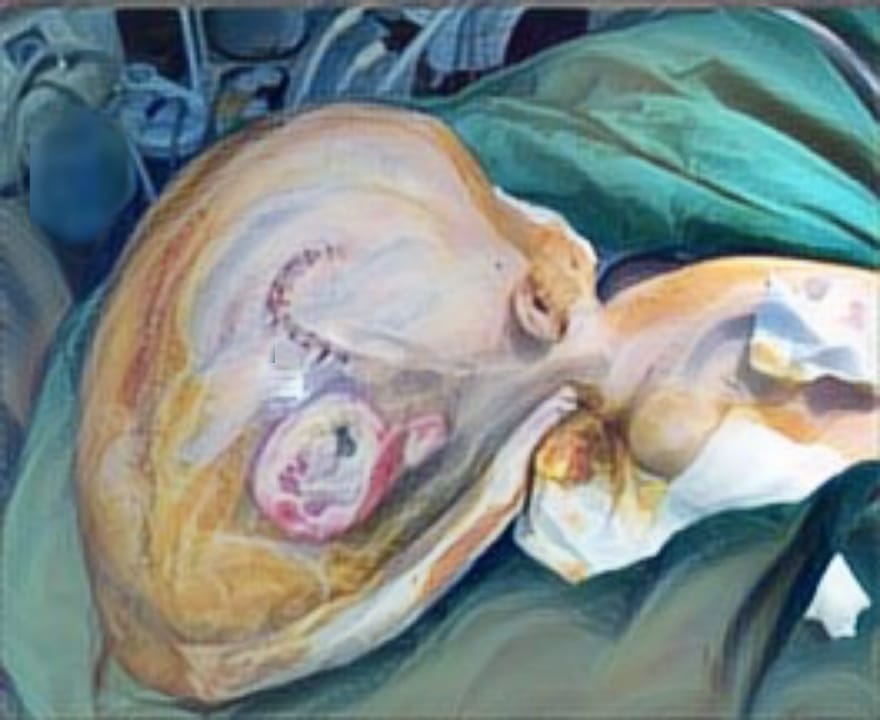PEDICLED ABDOMINAL FLAP FOR MALIGNANT DEFECT RECONSTRUCTION: A VIABLE ALTERNATIVE TO FREE FLAP

Downloads
Highlights:
- Pedicled abdominal flap remains a reliable reconstructive option in the era of microsurgery.
- Although a two-stage procedure, it provides safe and functional reconstruction.
- Compared to free flaps, it offers a simpler approach with fewer complications—crucial for cancer patients with limited prognosis.
Abstract:
Introduction: The pedicled abdominal flap, a commonly used reconstructive option, remains relevant in the era of advanced microsurgery despite the rising preference for free flaps. While free flaps offer advantages, they also carry risks of flap failure and require complex microvascular anastomosis, making them less suitable for certain patients.
Case Illustration: A 48-year-old female presented with a history of a non-healing ulcer over the left upper arm due to burn scarring from a flame injury sustained 20 years prior. Following tumor resection, debridement of the defect was done which showed complete loss of skin, subcutaneous tissue, and fascia of the upper arm. A rectangle shaped skin flap was designed on the left abdominal region on the same side as the defect on the affected upper arm. A pedicled axial fasciocutaneous flap was harvested from the left lumbar area of the abdomen, utilizing the paraumbilical perforators for vascularity.
Discussion: This case report highlights the use of the pedicled abdominal flap in the reconstruction of defects resulting from malignancy, emphasizing its reliability and suitability in such complex scenarios. For individuals with malignancy, the pedicled abdominal flap is often favored due to its safer, single-stage procedure, minimizing complications and re-operation risks.
Conclusion: Compared to free flaps, the pedicled abdominal flap is a preferable choice in reconstructing defects in cancer patients due to its reliability, reduced risk of flap failure, and relatively simple surgical procedure. This is particularly important for cancer patients, where the focus is on achieving functional reconstruction while considering patient's prognosis.
Nsaful KO, Koney CT, Brako EA, Toure TM, Avoka A, Afriyie AA, et al. The use of pedicled abdominal flap to salvage a necrotic forearm - a case study. Int Phys Med Rehabil J. 2020; 5(6):238–42. DOI: 10.15406/ipmrj.2020.05.00264
Asanuma K, Tsujii M, Hagi T, Nakamura T, Uchiyama T, Adachi R, et al. Pedicled flap transfer after chest wall malignant tumor resection and potential risk of postoperative respiratory problems for patients with low FEV1.0%. Front Surg. 2024; 11: 1357265. DOI: 10.3389/fsurg. 2024.1357265
Ylmaz S, Saydam M, Seven E & Ercocen AR. Paraumbilical perforator-based pedicled abdominal flap for extensive soft-tissue deficiencies of the forearm and hand. Ann Plast Surg. 2005; 54(4): 365–8. DOI: 10.1097/ 01.sap.00001548 71.97860.ea
Al-Qattan MM, Alammar AK, Alfaqeeh FA, Altamimi LA, Alfehaid NS, Mahabbat NA, et al. Pedicled abdominal flaps for hand reconstruction in adults: physiotherapy of the attached hand. Plast Reconstr Surg Glob Open. 2021; 9(3): e3474. DOI: 10.1097/GOX.0000000000003474
Ouyang S, Wu Z, Zhang Y & Lu X. Comprehensive analysis of risk factors for flap necrosis in free flap reconstruction of postoperative tissue defects in oral and maxillofacial tumors. Sci Rep. 2024; 14(1): 18676. DOI: 10.1038/s41598-024-69159-z
Sittitrai P, Ruenmarkkaew D & Klibngern H. Pedicled flaps versus free flaps for oral cavity cancer reconstruction: a comparison of complications, hospital costs, and functional outcomes. Int Arch Otorhinolaryngol. 2023; 27(1): e32–42. DOI: 10.1055/s-0042-1751001
Zhao J, Xian C, Yu J & Shi K. Pedicled full-thickness abdominal flap combined with skin grafting for the reconstruction of anterior chest wall defect following major electrical burn. Int Wound J. 2015; 12(1): 59–62. DOI: 10.1111/iwj.12051
Cammarata E, Toia F, Maltese M, Rossi M, Tripoli M & Cordova A. Soft tissue reconstruction of the trunk with pedicled perforator and musculocutaneous flaps: a single-center comparative retrospective study. Microsurgery. 2024; 44(1). DOI: 10.1002/micr.31131
Liang M, Luo Y, Wang X, Chen C, Chen P, Xiong Z, et al. Breast cancer patient flap management after mastectomy: a best practice implementation project. Clin Breast Cancer. 2025; 25(1): 46–55. DOI: 10.1016/j.clbc.2024.09.004
Jabaiti S, Ahmad M & AlRyalat SA. Reconstruction of upper extremity defects by random pedicle abdominal flaps: is it still a valid option? Plast Reconstr Surg Glob Open. 2020; 8(3): e2687. DOI: 10.1097/ GOX.00000 00000002687
Al-Qattan MM & Al-Qattan AM. Defining the indications of pedicled groin and abdominal flaps in hand reconstruction in the current microsurgery era. J Hand Surg Am. 2016; 41(9): 917–27. DOI: 10.1016/ j.jhsa.2016.06.006
Ang GG, Rozen WM, Chauhan A, & Acosta R. The pedicled "propeller" deep inferior epigastric perforator (DIEP) flap for a large abdominal wall defect. J Plast Reconstr Aesthetic Surg. 2011; 64(1): 133–5. DOI: 10.1016/j.bjps.2010.03.024
Prasetyo AT, Hasibuan LY & Arsyad M. Pedicled abdominal skin flap technique for fingers salvaging and reconstruction in a complex palmar hand burn injury: a case report. Int J Surg Case Rep. 2024; 114: 109199. DOI: 10.1016/j.ijscr.2023. 109199
Adidharma W, Tandon V, Grant D & Chung KC. Extended abdominal pedicled flap using a modified abdominoplasty incision for reconstruction of an extensive forearm defect. J Hand Surg Glob Online. 2022; 4(6): 367–71. DOI: 10.1016/j.jhsg.2022.07.005
Gabrysz-Forget F, Tabet P, Rahal A, Eric Bissada E, Christopoulos A & Ayad T. Free versus pedicled flaps for reconstruction of head and neck cancer defects: a systematic review. J Otolaryngol Head Neck Surg. 2019; 48:13. DOI:10.1186/s40463-019-0334-y
Karakawa R, Yoshimatsu H, Fuse Y & Yano T. Comparison of outcomes following pedicled and free flap transfers for the defect after shoulder sarcoma resection. J Plast Reconstr Aesthet Surg. 2023; 83: 373–9. DOI: 10.1016/j.bjps. 2023.04.04
Sittitrai P, Ruenmarkkaew D & Klibngern H. Pedicled flaps versus free flaps for oral cavity cancer reconstruction: a comparison of complications, hospital costs, and functional outcomes. International Archives of Otorhinolaryngology, 2023; 27:32-42. DOI:10.1055/s-0042-1751001
Katna R, Girkar F, Tarafdar D, Bhosale B, Singh S, Agarwal S, et al. Pedicled flap vs. free flap reconstruction in head and Neck cancers: clinical outcome analysis from a single surgical team. Indian Journal of Surgical Oncology, 2021; 12(3):472-476. DOI:10.1007/s13193-021-01353-1
Mahieu R, Colletti G, Bonomo P, Parrinello G, Iavarone A, Dolivet G, et al. Head and neck reconstruction with pedicled flaps in the free flap era. Acta Otorhinolaryngologica Italica, 2016; 36 (6): 459-468. DOI:10.14639/0392-100X-1153
Tabares BG, Geithner CMR, Pierpoline J & Mosquera C. Long-Term Functional Outcomes of Free Flaps Versus Locoregional Flaps in Soft Tissue Reconstruction for Oral Cavity Cancer: A Systematic Review. Journal of Craniofacial Surgery, 2025; 10-1097. DOI: 10.1097/SCS.0000000000011158
Trepka-Sirek B, Cholewka A, Bałamut K & Niedzielska I. The use of thermography in assessing the viability of pedicled and free flaps used in head and neck reconstructive surgery–preliminary study. Polish Journal of Medical Physics and Engineering, 2025; 31(1):73-80. DOI:10.2478/pjmpe-2025-0007
Tabares BG, Geithner CMR, Pierpoline J & Mosquera C. Long-Term Functional Outcomes of Free Flaps Versus Locoregional Flaps in Soft Tissue Reconstruction for Oral Cavity Cancer: A Systematic Review. J Craniofac Surg. 2025; DOI: 10.1097/SCS.00000000000 11158
Copyright (c) 2025 Bertha Kawilarang, Putu Trisna Utami

This work is licensed under a Creative Commons Attribution-ShareAlike 4.0 International License.
JURNAL REKONSTRUKSI DAN ESTETIK by Unair is licensed under a Creative Commons Attribution-ShareAlike 4.0 International License.
- The journal allows the author to hold copyright of the article without restriction
- The journal allows the author(s) to retain publishing rights without restrictions.
- The legal formal aspect of journal publication accessbility refers to Creative Commons Attribution Share-Alike (CC BY-SA)




















